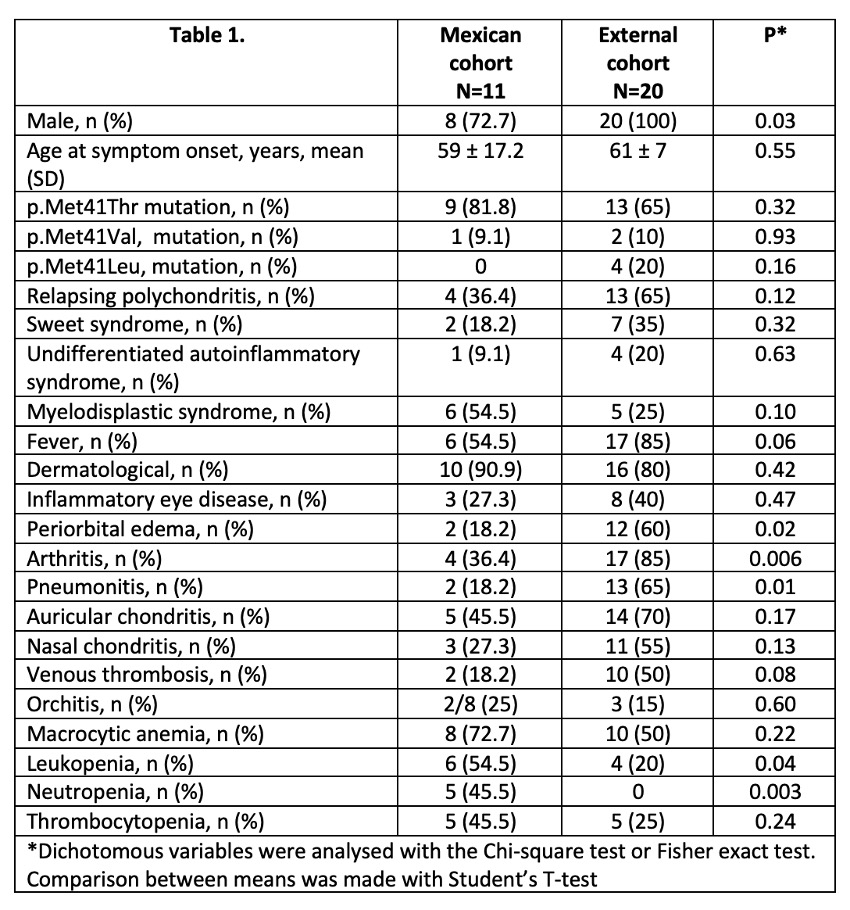Session Information
Date: Tuesday, November 14, 2023
Title: (1913–1944) Miscellaneous Rheumatic & Inflammatory Diseases Poster III
Session Type: Poster Session C
Session Time: 9:00AM-11:00AM
Background/Purpose: There is limited information on VEXAS syndrome in the Latin-American population. We aimed to identify UBA1 mutations causing VEXAS syndrome in Mexican patients presenting with inflammatory and hematologic manifestations.
Methods: We included patients who had (i) one or more inflammatory manifestations associated with VEXAS syndrome (e.g. chondritis, neutrophilic dermatoses, vasculitis, pneumonitis), and (ii) one or more chronic cytopenias, or isolated macrocytosis. Genomic DNA was extracted from peripheral blood or available biopsies (bone marrow or skin). To identify pathogenic UBA1 mutations, Sanger sequencing of exons 3, 14, and 16 was performed. To identify variables associated with a positive result, we compared UBA1-positive and UBA1-negative patients. The UBA1-positive patients were compared with an external cohort comprising 20 patients with VEXAS syndrome from the USA.
Results: A total of 29 patients were tested, of whom 11 had a mutation in UBA1 (positive detection rate: 37.9%). Eight were male (72.7%). The mean age at symptom onset was 59±17.2 years. The youngest patient was 23 y/o. Nine (81.8%) had the p.Met41Thr, and one each the p.Met41Val and p.Ser56Phe mutations. The clinical diagnoses (not mutually exclusive) were myelodysplastic syndrome in 6 (54.5%), relapsing polychondritis in 4 (36.5%), Sweet syndrome in 2 (18.2%), and one each of polyarteritis nodosa, type I cryoglobulinemia, pyoderma gangrenosum, thyroid orbitopathy, undifferentiated autoinflammatory syndrome, multiple myeloma, and chronic myeloid leukemia.
Clinical and hematological manifestations are summarized in Table 1. Ten patients (90.9%) had hematological manifestations, with macrocytic anemia being the most common in 8 cases (72.7%), although most had macrocytosis (90.9%). Out of the 7 patients who underwent a bone marrow aspirate, 4 (57.1%) had vacuoles. Glucocorticoids and immunosuppressors were prescribed to 7 patients (58.3%), while chemotherapeutic regimens were used in 2 (18.2%). The median number of treatment lines was 1.5 (IQR: 1-2.5). With a median follow-up of 44 months (IQR 24-66), two patients had died.
The presence of macrocytosis (OR: 12.5, CI: 1.3-119.3) and macrocytic anemia (OR: 6.9, CI: 1.2-37.2) were associated with the presence of a pathogenic UBA1 mutation. Conversely, having a clinical diagnosis other than the most reported in VEXAS syndrome exhibited a negative association with a positive UBA1 mutation (OR: 0.064, CI: 0.007-0.612).
Compared to the external cohort, our patients showed higher frequencies of female patients, leukopenia, and neutropenia, but lower frequencies of fever, periorbital edema, arthritis, pneumonitis, and venous thrombosis (Table 1).
Conclusion: Patients with clinical diagnoses commonly associated with VEXAS syndrome, along with the presence of macrocytosis or macrocytic anemia, have an increased likelihood of harboring a pathogenic UBA1 mutation. While our cohort displayed some distinct clinical and hematologic manifestations compared to the USA cohort, the type of UBA1 mutations and clinical diagnoses were consistent. Noteworthy, our cohort included a higher proportion of female patients and one of the youngest ever reported cases of VEXAS.
To cite this abstract in AMA style:
Martin-Nares E, Sánchez-Hernández B, Grayson P, Crispin J, Montante-Montes de Oca D, Hinojosa-Azaola A, Hernandez-Molina G, Apodaca E, Groarke E, Delgado-de la Mora J, Méndez-Flores S, Gamboa-Domínguez A, Patel B, Ferrada M. Identification of VEXAS Syndrome in Mexican Patients with Inflammatory and Hematologic Manifestations [abstract]. Arthritis Rheumatol. 2023; 75 (suppl 9). https://acrabstracts.org/abstract/identification-of-vexas-syndrome-in-mexican-patients-with-inflammatory-and-hematologic-manifestations/. Accessed .« Back to ACR Convergence 2023
ACR Meeting Abstracts - https://acrabstracts.org/abstract/identification-of-vexas-syndrome-in-mexican-patients-with-inflammatory-and-hematologic-manifestations/

